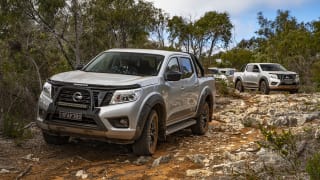We tested the new GLS Premium trim which has replaced the Exceed as the Triton line-up’s top-shelf model. It is available only as a dual-cab 4x4 in pick-up body style with an automatic transmission and costs $51,990 – a $3000 increase over the Exceed’s price, but the GLS Premium does come packed with standard features, a heap of accessories and is currently being advertised on the Mitsubishi Australia website as $50,990 drive-away.
Over and above the GLS’s standard gear – including chrome grille, HID headlights, LED daytime running lights, chrome exterior handles, leather steering wheel and shifter knob, six-speaker audio system, power folding door mirrors, chrome sports bar and 18-inch wheels – the Premium gets push-button start, nudge bar, leather-look door trim inserts, heated front seats, electric driver-seat adjustment, leather seats, paddle shifters, a surround-view camera system and rear diff lock.
It gets a stack of safety tech including forward collision mitigation (which incorporates AEB), lane-departure warning, blind-spot monitoring, rear-cross-traffic alert, lane-change assist, front and rear parking sensors, reversing camera, stability control, seven airbags, as well as auto headlights and wipers, and hill descent control.
Our tester had a nudge bar and substantial easy-to-use side steps.


















